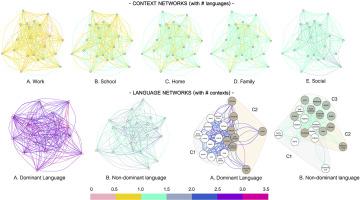当前位置:
X-MOL 学术
›
J. Neurolinguistics
›
论文详情
Our official English website, www.x-mol.net, welcomes your
feedback! (Note: you will need to create a separate account there.)
Using network science to map what Montréal bilinguals talk about across languages and communicative contexts
Journal of Neurolinguistics ( IF 1.2 ) Pub Date : 2020-11-01 , DOI: 10.1016/j.jneuroling.2020.100913 Mehrgol Tiv 1 , Jason Gullifer 1 , Ruo Feng 1 , Debra Titone 1
Journal of Neurolinguistics ( IF 1.2 ) Pub Date : 2020-11-01 , DOI: 10.1016/j.jneuroling.2020.100913 Mehrgol Tiv 1 , Jason Gullifer 1 , Ruo Feng 1 , Debra Titone 1
Affiliation

|
Recent work within the language sciences, particularly bilingualism, has sought new methods to evaluate and characterize how people differentially use language across different communicative contexts. These differences have thus far been linked to changes in cognitive control strategy, reading behavior, and brain organization. Here, we approach this issue using a novel application of Network Science to map the conversational topics that Montréal bilinguals discuss across communicative contexts (e.g., work, home, family, school, social), in their dominant vs. non-dominant language. Our results demonstrate that all communicative contexts display a unique pattern in which conversational topics are discussed, but only a few communicative contexts (work and social) display a unique pattern of how many languages are used to discuss particular topics. We also demonstrate that the dominant language has greater network size, strength, and density than the non-dominant language, suggesting that more topics are used in a wider variety of contexts in this language. Lastly, using community detection to thematically group the topics in each language, we find evidence of greater specificity in the non-dominant language than the dominant language. We contend that Network Science is a valuable tool for representing complex information, such as individual differences in bilingual language use, in a rich and granular manner, that may be used to better understand brain and behavior.
中文翻译:

使用网络科学绘制蒙特利尔双语者在不同语言和交际环境中谈论的内容
语言科学领域的近期工作,尤其是双语学,寻求新方法来评估和表征人们如何在不同的交际环境中差异化地使用语言。迄今为止,这些差异与认知控制策略、阅读行为和大脑组织的变化有关。在这里,我们使用网络科学的一种新颖应用来解决这个问题,以映射蒙特利尔双语者在他们的主导语言和非主导语言中跨交际环境(例如,工作、家庭、家庭、学校、社交)讨论的对话主题。我们的结果表明,所有交际语境都显示出一种讨论对话主题的独特模式,但只有少数交际语境(工作和社交)显示出使用多少语言来讨论特定主题的独特模式。我们还证明了主导语言比非主导语言具有更大的网络规模、强度和密度,这表明在这种语言的更广泛的上下文中使用了更多的主题。最后,使用社区检测对每种语言的主题进行主题分组,我们发现非主导语言比主导语言具有更大的特异性的证据。我们认为,网络科学是一种有价值的工具,可以以丰富而细致的方式表示复杂信息,例如双语使用中的个体差异,可用于更好地理解大脑和行为。使用社区检测对每种语言的主题进行主题分组,我们发现非主导语言比主导语言具有更大的特异性的证据。我们认为,网络科学是一种有价值的工具,可以以丰富而细致的方式表示复杂信息,例如双语使用中的个体差异,可用于更好地理解大脑和行为。使用社区检测对每种语言的主题进行主题分组,我们发现非主导语言比主导语言具有更大的特异性的证据。我们认为,网络科学是一种有价值的工具,可以以丰富而细致的方式表示复杂信息,例如双语使用中的个体差异,可用于更好地理解大脑和行为。
更新日期:2020-11-01
中文翻译:

使用网络科学绘制蒙特利尔双语者在不同语言和交际环境中谈论的内容
语言科学领域的近期工作,尤其是双语学,寻求新方法来评估和表征人们如何在不同的交际环境中差异化地使用语言。迄今为止,这些差异与认知控制策略、阅读行为和大脑组织的变化有关。在这里,我们使用网络科学的一种新颖应用来解决这个问题,以映射蒙特利尔双语者在他们的主导语言和非主导语言中跨交际环境(例如,工作、家庭、家庭、学校、社交)讨论的对话主题。我们的结果表明,所有交际语境都显示出一种讨论对话主题的独特模式,但只有少数交际语境(工作和社交)显示出使用多少语言来讨论特定主题的独特模式。我们还证明了主导语言比非主导语言具有更大的网络规模、强度和密度,这表明在这种语言的更广泛的上下文中使用了更多的主题。最后,使用社区检测对每种语言的主题进行主题分组,我们发现非主导语言比主导语言具有更大的特异性的证据。我们认为,网络科学是一种有价值的工具,可以以丰富而细致的方式表示复杂信息,例如双语使用中的个体差异,可用于更好地理解大脑和行为。使用社区检测对每种语言的主题进行主题分组,我们发现非主导语言比主导语言具有更大的特异性的证据。我们认为,网络科学是一种有价值的工具,可以以丰富而细致的方式表示复杂信息,例如双语使用中的个体差异,可用于更好地理解大脑和行为。使用社区检测对每种语言的主题进行主题分组,我们发现非主导语言比主导语言具有更大的特异性的证据。我们认为,网络科学是一种有价值的工具,可以以丰富而细致的方式表示复杂信息,例如双语使用中的个体差异,可用于更好地理解大脑和行为。











































 京公网安备 11010802027423号
京公网安备 11010802027423号